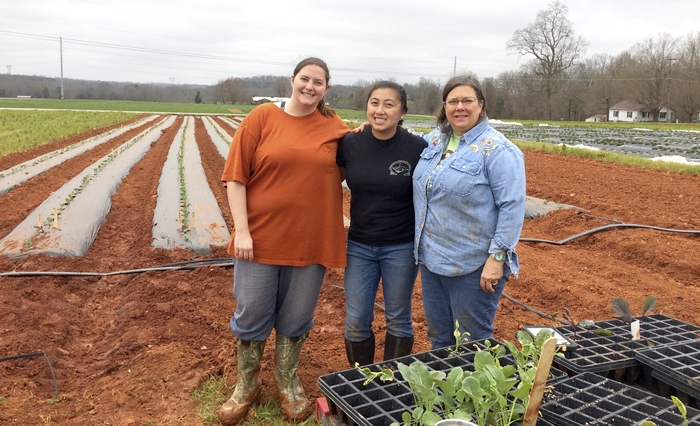Amy-Lynn Albertson: Red dirt of clay soils can be improved
Published 12:00 am Friday, May 13, 2016

- Cooperative Extension Extension agents Danélle Cutting, Der Xiong and MaryJac Brennan pose in a red clay field at the Piedmont Research Station.
SALISBURY — Many people, when they move to the Piedmont, are bamboozled by our red dirt. My soil science professor is screaming at me right now from Colorado that it is not dirt, it’s SOIL.
OK so red soil is not a disaster or a death sentence to all plants. Red soil is actually pretty awesome. You have a problem if you soil is a sticky gray or whitish color. Much of the subsoil in the Piedmont and mountain regions of North Carolina have high clay content—commonly called “heavy” soil.
If the native soil has been removed and replaced around your home site during construction, this subsoil may now be at the surface. Soils with high clay content tend to have slow water movement and may remain wet for long periods of time. Construction will also cause compaction of the soil, making drainage even slower and adding to poor plant growth.
If you have poor soil, or poorly drained soil, all is not lost. There are many things a gardener can do to improve their soil. Increasing the amount and size of pore spaces is an important first step toward improving the soil.
A healthy soil typically has more than 40 percent pore space, ranging from large pores, which allow drainage, to small pores, which help store water. Soils made up of small soil particles, such as heavy clay soils, naturally tend to have more small pores, even without compaction, making them difficult to work, difficult to wet and hard to aerate.
Several methods can increase pore space in your clay soil. While it is true that adding sand will increase the size range of the soil particles and pore spaces, it would take four to five times the volume in sand to have a measurable effect. By adding smaller amount of sand it actually has a negative effect, producing a concrete like material.
Let me repeat, do not add sand to your clay soils. A lot of people like to go out and get topsoil to add to their soil. Sometimes this works, especially for small areas, but can be expensive for larger areas. In addition, there are no legal standards for topsoil. What is sold as topsoil may be no better than what you already have and may introduce new problems like weeds and soil-borne diseases.
A more cost-effective solution for larger areas is to add organic materials, such as composted leaves, grass or wood bark. These materials will, over time, improve the structure and porosity of the soil and may enhance both drainage and nutrient retention.
It is important to use materials that have first been composted, because fresh organic materials will settle as they decompose. In the short term, adding organic materials may also increase the need for nitrogen, which is consumed by microbial activity during decomposition. However, in the long term, organic material added over several growing seasons will lead to richer soil.
You may read in some gardening books that peat is good to add to your soil for the same purposes as compost. However, peat is not recommended for soils with high clay content. It tends to behave somewhat like clay in that peat is slow to absorb water, but it also tends to retain water and remain wet. We don’t need to make our soils any wetter, so stay away from peat.
Composted materials provide a better alternative for improving physical properties. Topsoil or soil amendments should be mixed or tilled into the existing soil, rather than merely placed on top, to improve water movement and encourage deeper root growth. Amendments should be added to no more than half the depth of the tiller tines (usually no more than 3 to 4 inches) in a single application.
The Rowan County Master Gardeners will hold a workshop on gardening in poor soils or slopes as part of their DIY Gardening Series on Saturday, May 21, from 9:30-11:30 a.m. at the Rowan County Extension Center. Please call 704-216-8970 to register or for more information.




